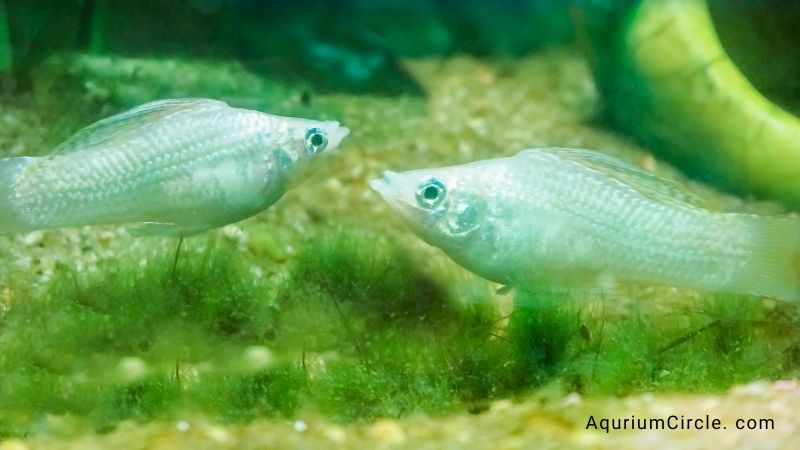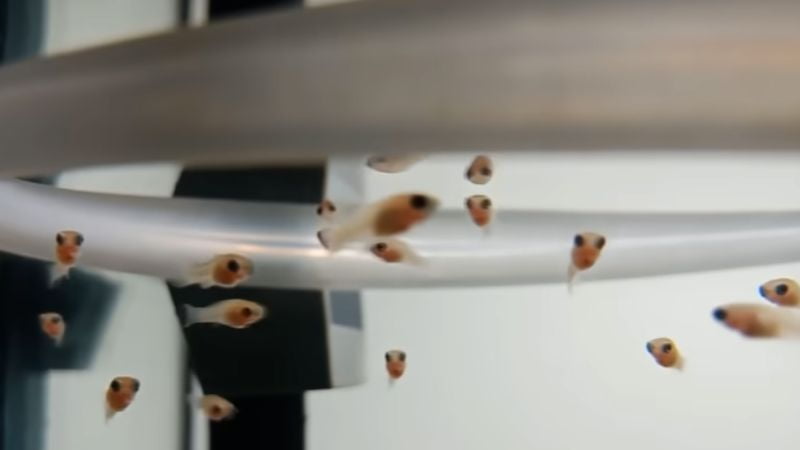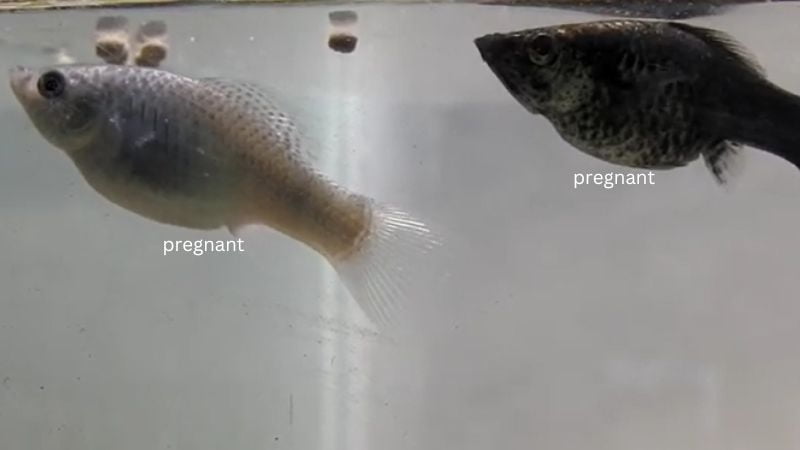Since they are known for their toughness and vivacious personalities, molly fish is a popular choice for freshwater aquariums. If you keep a female molly fish in your tank, it’s crucial to understand how to recognize pregnancy symptoms and take good care of your expecting molly. In this post, we’ll go over how to tell if your molly fish is pregnant, how to be ready for the birth of baby mollies, and how to protect both the mother and the young to ensure their safety and wellbeing.
Pregnant Molly Fish Stages
Before giving birth, a pregnant Molly fish goes through 5 developmental stages. The Molly fish will heal after giving birth to the fry before trying to get pregnant again.
- The conception: If your aquarium has both male and female mollies, it should be rather simple. In addition, female mollies fertilize their eggs once a month using sperm that they had stored from a single mating.
- Gestation period: An embryo develops from the fertilized eggs after fertilization. The gravid area is now easy to observe around seven days after conception.
- Develop into molly fry: As the pregnancy progresses, the embryos now transform into molly fry. The tummy of the pregnant molly swells as a result of this growth.
- The pre-birth stage: The fries are currently ready for delivery and have reached full development. You might be able to see the fry eyeballs in their mothers’ bellies if you closely observe the pregnant fish.
- Giving birth stage: Fish are born alive by their mother, molly, when they are ready to give birth. The moment these small ones are delivered, they can swim. But, you must keep molly fries away from their mothers since they will happily devour them.
Pregnant Molly Fish Signs
There are various physical signs of pregnancy in molly fish. The female molly’s tummy will grow larger as the pregnancy proceeds, which is the most evident indicator. This is because molly, the female, is carrying around eggs that will eventually hatch into fry or young fish. You can be better equipped to take care of your pregnant Molly fish and her fry by being aware of these symptoms.
Molly has a swollen belly
While female molly fish have a naturally large belly, males have a torpedo-shaped bodies. Molly’s tummy gets rounder and thicker during pregnancy. A few weeks after conception, the mother’s belly will appear to be stretched out.
Dark gravid spots appear
The anal vent is a livebearer’s closest gravid location. When a woman is preparing to give birth, this region gets bigger.
Molly fish that are pregnant first have a blackish mark on their gravid area. This mark becomes more noticeable over time, especially in mollies of lighter hues. In black mollies, you could encounter some difficulties locating this location.
Aggressive behaviors
Molly fish that show signs of hostility and seclusion are likely to be pregnant when molly is pregnant. Molly spends her days hiding as she prepares to give birth while pregnant. In their hiding spaces, the fish are more secure and at ease. Moving your pregnant molly fish to a different aquarium will keep them comfy. If you don’t have a separate tank, think about enhancing privacy by adding extra live plants or decorative plants.

Increased appetite
Due to the additional energy their bodies require to care for the fry, and pregnant mollies have an increased appetite. During feeding periods, mollies become more energetic and may begin squabbling over food.
Yet, the phase of increased appetite is brief. Instead, it gets smaller as labor time draws near. Your pregnant mollies will be more interested in solitude than food.
Warmth wanted
It makes sense that pregnant mollies would look for warmth. We advise that you keep your temperature steady throughout the pregnancy period. This ensures the female molly fish’s and the young fry’s health.
Pregnant Molly Fish Caring
Molly fish that are pregnant need to be handled with special caution to protect both the mother and her fry. Mollies that are pregnant need lots of hiding spots and a calm atmosphere to lower stress levels, which might impair their pregnancy. Feeding is particularly crucial since pregnant mollies need a balanced diet that includes lots of foods high in protein, like bloodworms and brine shrimp. Live plants can provide as a natural hiding spot for the fry once they are born, which may be advantageous to pregnant mollies as well. To guarantee the best conditions for the mother and her progeny, it is also crucial to regularly monitor water quality and carry out routine water changes.
How to set up a separate tank
To keep pregnant mollies content and relaxed, keep them apart from other fish. Moreover, it stops the adult fish from devouring her fry. Use water from the main tank throughout the transfer to avoid any unexpected water fluctuations. None of these demand a lot of setups, aquarist involvement, or expensive equipment. Designate a separate tank to raise the babies if your goal is to raise as much fry as you can.
Sadly, that also applies to infant fry. Also, if you keep your mollies in a communal tank, the other fish in the tank can also think the free-swimming fry are appetizing delicacies. A tank that is 25 to 30 gallons (95 to 114 l) in size is a good size for breeding and rearing fry.
Add a heater
The water doesn’t need to undergo any special modifications in order for molly fish to begin reproducing. Maintain the same water conditions in both the community tank and the breeding tank. To maintain the tank clean, replace 10% to 30% of the water each week. Because molly fish have a famously high bio load, regular tank maintenance will result in healthy fish and fry. To give the pregnant molly more places to hide, add lots of living plants and decorations. When they are about to give birth, mollies like darker spots.
| Temperature | 70 to 82°F (21 to 27.7°C) |
| pH level | 7.5 to 8.5 |
| Hardness | 15 to 30 dGH |
Molly Fish Giving Birth Signs
Knowing this is crucial because she and the fries are at a vulnerable point right now. These behavioral indicators suggest that she might be prepared to give birth. A pregnant molly’s gravid spot gets darker and more noticeable as she approaches releasing her live young. The fry eyeballs are more apparent at this point. She will avoid other fish, have a smaller appetite, and show lethargic symptoms. If the tank is densely vegetated, it could be difficult to see the female, and she might delay feeding.
Female mollies have round bellies, and because the womb is fully expanded, they also plump out beneath their gills. Likewise, unless the tank water is very acidic, adult mollies hardly ever wiggle their tails. But, when mollies are preparing to give birth, they shake their tails. The stress of childbirth frequently causes this behavior.
As usual, staying still for a very long time. She begins to slink underneath the tank’s ornaments or plants. She might even continue to hang around the tank heater to keep warm.
How To Save The Baby Molly

If you want to save the baby mollies, it is important to provide them with a separate tank where they can grow and develop away from potential predators or aggressive tank mates. You should also ensure that the water in the tank is clean and free from any toxins or contaminants that may harm the baby mollies.
Move the mother molly out.
Save molly’s fries by removing molly’s mother from the main tank. Most of the mother’s babies will be devoured by adult mollies if she is kept in the main tank. The new tank gives the fry greater freedom and room to swim.
Add plants
If you don’t have a breeding box or tank, provide the fry places to hide. To protect the fry from the adults, you may include living plants, caverns, rocks, and other decorations. A few floating plants, such as java moss, duckweed, or hornwort, should be included.
How many babies will molly come?
A molly fish that is pregnant can give birth to 20 to 100 or even more fry. The number of offspring is influenced by a number of variables, including the mother’s age, the tank’s size, the water’s quality, and feeding patterns. Larger and older females typically produce more offspring than younger ones.
Equipment
Use a sponge filter to prevent your little fry from being dragged in by the current to safeguard them. The substrate can be kept clean by using a gravel vacuum. For your breeding tank to maintain a constant temperature, you will also need a heater and thermometer.
How Does Molly Breed?
Even inexperienced aquarists can succeed in breeding molly fish. Mollies reproduce fast, so be ready to care for a lot of young throughout the year. Unlike other fish breeds, mollies do not deposit eggs. They give birth to live fish instead. When the eggs are within the female, male mollies fertilize them. Without needing to mate, the female molly can continue bearing children and store sperm.
The gestation period of molly fish lasts 40 to 60 days.
Is Molly easy to breed?
Breeding the molly fish is quite simple. Like guppies, molly fish frequently spawn without any assistance from humans. The female molly, also known as Poecilia sphenops, will carry the eggs in her belly and give birth to free-swimming fry when the time comes. Mollies are also livebearers. One of the reasons specialists advise aquarists to set up a separate birthing tank is this.
The baby fish are vulnerable to other fish swimming in the tank. Thus doing this helps to guarantee that the fry has the best chance of surviving.
FAQs
When is the molly fish pregnant?
After they achieve sexual maturity, which usually occurs between the ages of 3-6 months, molly fish are capable of becoming pregnant at any time. They are livebearers, which means that rather than laying eggs, they give birth to live young. For pregnant molly fish, the gestation period lasts about 4-6 weeks.
What fish can molly breed with?
Mollies can breed with other mollies, including different varieties such as black mollies, silver mollies, and sailfin mollies. They can also interbreed with other species in the same genus, such as guppies and swordtails. However, it is generally recommended to avoid crossbreeding to maintain the purity of each species.
How long is pregnant molly fish?
The gestation period of a pregnant molly fish is around 4 to 6 weeks, depending on the water temperature and other environmental conditions.
References:
- Wikipedia – https://en.wikipedia.org/wiki/Poecilia_sphenops
- wikiHow – https://www.wikihow.com/Breed-Molly-Fish

Annette M. Chaney is an experienced marine biologist with over 20 years of experience as an aquarist and fishkeeper. She started her first aquarium at a young age, filling it with frogs and goldfish obtained from the ten-cent pet store.
Annette grew up caring for and breeding African Cichlids, which led to a hobby in high school that doubled as a profitable means. Attending Reed College gave her time to solidify herself as an accomplished aquarium caretaker with an eye for sales. After that, from 2009 – 2013, she studied at Roger Williams University – one of the most prestigious universities for Aquaculture and Aquarium in USA. She is the founder of AquariumCircle since 2010.
